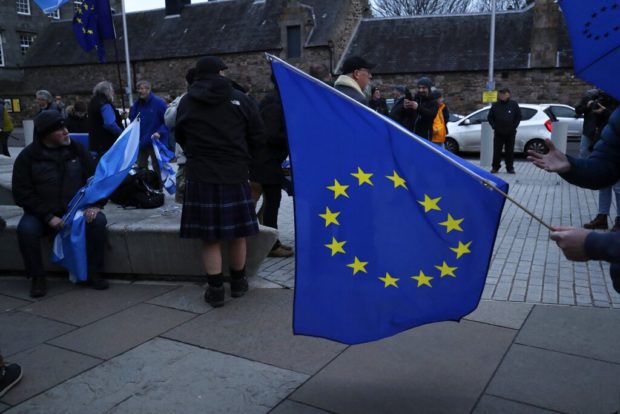LONDON — Britain is leaving the European Union after 47 years of membership. That’s just the first stage of a journey that still has many twists in store.
The U.K. is quitting a 28-nation bloc of almost half a billion people which for decades has helped set rules for U.K. trade, farming, environmental protection and much more. The break comes at 11 p.m. London time (2300 GMT, 6 p.m. EDT) Friday.
Here’s a look at what happens next.
WHAT WILL CHANGE?
Most people in Britain and the EU will notice little change this year.
The two sides negotiated a divorce deal that includes an 11-month “transition period,” in which relations will stay essentially unchanged. The U.K. will continue to follow EU rules, although it will no longer have a say in EU decision-making.
Citizens of all both Britain and the 27 EU countries can continue to travel, work and live anywhere across that territory for the rest of the year, and U.K. businesses effectively remain part of the EU’s single market for goods and services.
Some people will be affected immediately, however. Beginning Saturday, British citizens in some EU countries will lose the right to vote or run for office in local elections.
WHAT HAPPENS NEXT?
Britain’s departure on Friday marks the end of stage one of Brexit: the amicable divorce.
Next comes the bit that maybe even trickier: forging a new relationship. That means a trade deal, but also agreements covering everything from security to telecoms policy. The two sides have agreed to strike an “ambitious, broad, deep and flexible partnership,” including a free trade deal, by Dec. 31.
Britain and the EU will set out their initial positions within days, although in-depth negotiations are not due to begin until March.
WHAT ARE THE TRICKY AREAS?
The two sides are starting out with firm positions that appear to set them on a collision course.
Britain says it wants a “Canada-style” free trade agreement with the EU covering both goods and services. But it is adamant it won’t agree to follow the EU’s rule book in return for unfettered trade, because it wants to be free to diverge in order to strike other new deals around the world.
The bloc insists there can be no trade deal unless Britain agrees to a “level playing field” and does not undercut EU regulations.
One likely conflict point is fishing. Taking back control of U.K. waters for U.K. fishermen is a totemic issue for Brexiteers. But the bloc could make getting a deal in other areas, such as financial services— which is a much larger slice of the British economy — contingent on allowing EU fishing boats continued access to U.K. waters.
The two sides also need to talk about security cooperation, to ensure there are no gaps in efforts to fight terrorism, trafficking, money-laundering or cross-border crime.
Sealing a deal will require compromises and trade-offs — but for now both sides are talking tough.
WHAT HAPPENS IN 2021?
This is the great unknown.
The EU is willing to extend Britain’s transition period for up to two years if a trade agreement hasn’t been reached, but Conservative British Prime Minister Boris Johnson says he won’t agree to that. The U.K. government insists 11 months is ample time to seal a deal, but the EU points out that such agreements typically take years.
The EU-Canada deal that the British government cites as a model took seven years to negotiate.
If there is no deal by the end of 2020, and the U.K. refuses to extend the negotiating period, Britain faces an abrupt, disruptive economic break from the bloc — with tariffs and other obstacles to trade imposed immediately between the U.K. and the EU. That would likely bring severe economic disruptions, the pound would plunge and Britain could tip into recession. Limits or holes in cross-border security efforts could even allow gangs or terrorists to flourish.
If time is running out, the two sides may agree to strike a bare-bones trade deal, with plenty of gaps to be filled in later.
